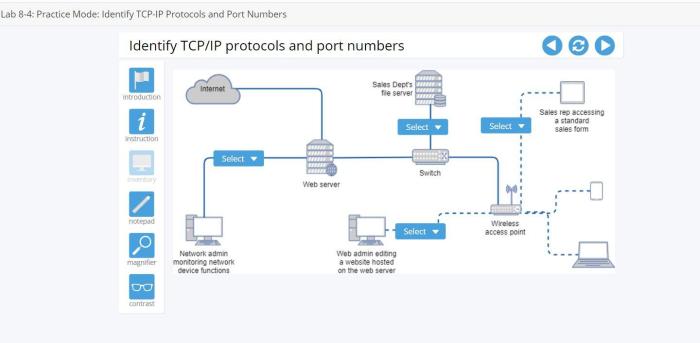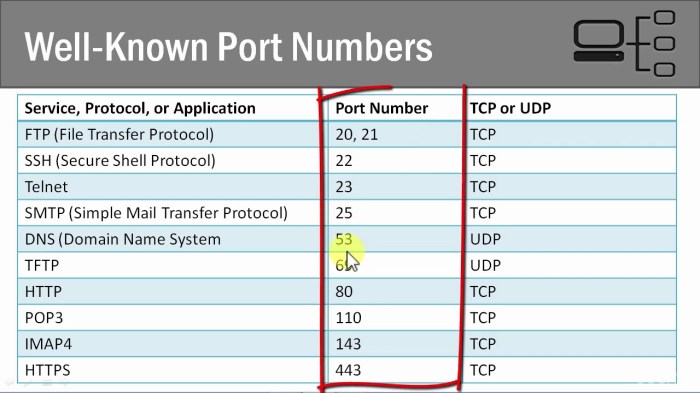Lab 8-4 testing mode identify tcp-ip protocols and port numbers – In the realm of network analysis, Lab 8-4 emerges as a pivotal tool, empowering network engineers and enthusiasts alike to delve into the intricacies of TCP-IP protocols and port numbers. This comprehensive guide embarks on a journey through the depths of Lab 8-4, deciphering the significance of each protocol and port, and unlocking the secrets of network troubleshooting.
As we traverse this labyrinth of networking knowledge, we will unravel the complexities of TCP-IP, deciphering the functionalities and characteristics of each protocol. We will embark on a voyage through port numbers, understanding their significance and unraveling the mysteries of well-known and dynamic port assignments.
Armed with this newfound knowledge, we will delve into the advanced configuration and analysis options within Lab 8-4, empowering ourselves to tackle even the most intricate network challenges.
Lab 8-4 Testing Mode: Overview
Lab 8-4 testing mode is a powerful tool used in network analysis and troubleshooting. It allows network administrators to examine and identify network traffic in detail, enabling them to diagnose and resolve network issues efficiently.
To enter testing mode, type “lab 8-4” at the command prompt. To exit testing mode, type “exit”.
Identifying TCP-IP Protocols
Lab 8-4 testing mode supports the identification of a wide range of TCP-IP protocols, including:
- HTTP (Hypertext Transfer Protocol)
- HTTPS (Secure Hypertext Transfer Protocol)
- FTP (File Transfer Protocol)
- SSH (Secure Shell)
- Telnet (Remote Login Protocol)
- SMTP (Simple Mail Transfer Protocol)
- DNS (Domain Name System)
- ICMP (Internet Control Message Protocol)
Each protocol serves a specific purpose and has its own unique characteristics.
Port Number Analysis

Lab 8-4 testing mode also allows for the analysis of port numbers. Port numbers are used to identify the specific service or application that is using a particular TCP or UDP port.
| Protocol | Port Number | Service |
|---|---|---|
| TCP | 21 | FTP |
| TCP | 22 | SSH |
| TCP | 80 | HTTP |
| UDP | 53 | DNS |
Well-known port numbers are assigned to commonly used services, such as web servers (port 80) and email servers (port 25). Dynamic and private port numbers are assigned dynamically by the operating system or used by applications for specific purposes.
Network Troubleshooting using Lab 8-4

Lab 8-4 testing mode can be used to troubleshoot a variety of network issues, including:
- Identifying network connectivity problems
- Diagnosing routing issues
- Troubleshooting application-specific network problems
By examining the network traffic and identifying the specific protocols and port numbers involved, network administrators can pinpoint the source of the problem and take steps to resolve it.
Advanced Configuration and Analysis

Lab 8-4 testing mode offers advanced configuration options that allow for in-depth network analysis and debugging. These options include:
- Filtering traffic based on specific criteria
- Capturing and analyzing network packets
- Performing network performance measurements
These advanced options are particularly useful for network engineers and security professionals who need to perform detailed network analysis and troubleshooting.
Quick FAQs: Lab 8-4 Testing Mode Identify Tcp-ip Protocols And Port Numbers
What is the significance of Lab 8-4 testing mode?
Lab 8-4 testing mode provides a controlled environment for testing and troubleshooting network configurations, allowing network engineers to isolate and analyze network issues without disrupting live traffic.
How do I enter and exit Lab 8-4 testing mode?
To enter Lab 8-4 testing mode, you typically need to access the router’s configuration interface and enable the testing mode option. To exit testing mode, simply disable the option and reboot the router.
What are some common TCP-IP protocols encountered in Lab 8-4?
Common TCP-IP protocols include HTTP (port 80), HTTPS (port 443), FTP (port 21), SSH (port 22), Telnet (port 23), and DNS (port 53).